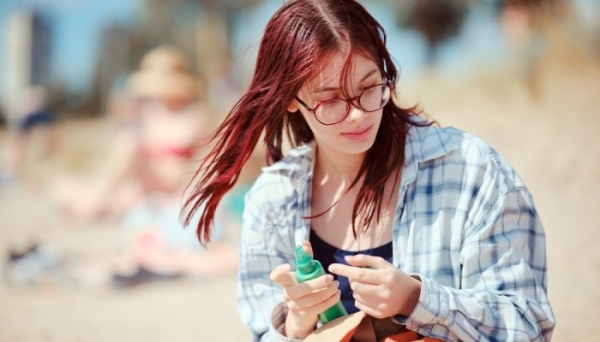
Several surveys have shown that sunscreen use among teens and young adults is dramatically insufficient despite health recommendations. Particularly concerned about their appearance, younger generations may neglect sun protection, preferring to get a natural tan. This summer, the phenomenon seems to have taken on new dimensions with a profusion of misinformation and wacky trends on social networks, particularly TikTok.
In its June issue, GQ China captured global attention with its bold Heat Stroke editorial, where models sported a look inspired by the aftermath of intense sun exposure. On social media, these photos have spawned a wave of tutorials explaining how to recreate these looks with makeup. Thus, ‘Heat stroke makeup’ or ‘Sunburn makeup’ was among the big trends this summer on Tiktok.
While recreating the appearance of sunburn with makeup tricks isn’t inherently dangerous, the trend reflects a generally worrying attitude toward sun protection among younger generations.
According to a recent survey by the French Federation of beauty companies (FEBEA), 39% of French people believe they can do without sunscreen because “they don’t really need it”, a rate which rises to 46% among men and young people aged 25 to 34.
Similarly, a recent survey from the American Academy of Dermatology (AAD) revealed that 52% of Gen Z adults ages 18 to 26 are unaware of key sunburn risks, such as increased skin cancer risk and premature aging. While over 50% of Americans earned an “A” or “B” in sun protection knowledge, data found 32% of Gen Z adults receive a grade of “D” or “F.”
Mass misinformation
This summer, in the United States, several doctors and dermatologists have warned about the proliferation of whimsical posts on social networks regarding sun protection.
According to a survey conducted this year by Ipsos for the Orlando Health Cancer Institute, one in seven American adults under 35 think daily sunscreen use is more harmful than direct sun exposure, and nearly a quarter believe staying hydrated can prevent a sunburn.
Home-made sunscreens
The growing distrust towards UV filters, which coincides with other trends such as the preference for natural products, but also a growing mistrust of the public towards established medical guidelines, also fuels a growing interest in homemade sunscreen products.
In early summer, a TikTok video posted by the influencer Nara Smith went viral, showing users how to make their own sunscreen. In the video, seen over 26 million times, Nara Smith’s husband, Lucky Blue Smith, mixes coconut oil, shea butter, cocoa butter, beeswax and jojoba oil. After melting these ingredients in a bowl over boiling water, he adds zinc oxide powder, then lets the mixture cool in the refrigerator before applying it to the skin.
Although this recipe, unlike others, does include a classic ingredient in sunscreens, namely zinc oxide, it does not offer any guarantee in terms of protection, many experts have reacted.
Sunburn, a bizarre acne remedy making the social media rounds
Again on TikTok, Internet users have apparently found a new “remedy” for acne: sunburn.
Numerous videos of influencers showing off their intensive tanning sessions to get rid of their pimples have gone viral on TikTok. One such video, for example, has racked up nearly 2 million views, with the influencer Haley Wenthold showing her face exposed to UV rays in the hope of making her imperfections disappear.
There is no need to dwell here on the dangers of such a practice or on its long-term ineffectiveness, which is widely documented and often recalled in the comments of these same videos.
The key role of self-image
What the origin of such a massive failure? Is it the lack of control over the messages broadcast on social networks, to which young people are massively exposed? Or is it an inadequacy of prevention messages to the real expectations of this generation?
Image is so important to this age group that the visual appeal of the tanned skin far outweighs any protection message. ” “We’ve seen tremendous advancement in sunscreen options over the past 10 years that can and should be easily incorporated into a routine. However, we are not seeing its use at the level we would expect considering the evidence showing regular use of sunscreen slows the aging process and decreases risk of skin cancer,” said Seattle-based board-certified dermatologist Heather D. Rogers, MD, FAAD. “What people don’t realize is that tan is a sign your skin has been injured,” she added.
Today, most sun safety recommendations are the same for people of all ages. Guidelines specifically aimed at younger people would probably be useful!




